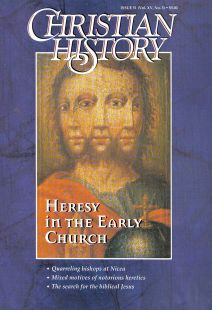From the Editor — How to Read This Issue
IT’S BEEN SAID, “God writes straight with crooked lines,” meaning God has allowed heresy to arise to help Christians clarify what they believe.
Well, most of the time.
If, after reading this issue, you can’t wax eloquent on the difference between Monophysitism and Nestorianism, I won’t hold it against you. I’ve been editing this issue for months now, and every time I’ve run into those and other arcane terms, I’ve had to thumb through the Oxford Dictionary of the Christian Church and assorted other reference works to make sure I know what I’m editing!
This is Christian History’s first foray into the heady topic of the history of theology. We now remember why we’ve procrastinated entering this field. It’s no easy task shaping intricate, complex thinking into understandable and interesting prose. If you hadn’t consistently rated heresy in the early church as one of your most desired topics, I don’t know that we would have produced this issue.
But you did, and so we have, and I’m excited about the result. We included as many stories, personalities, and fascinating facts as space permitted. The opening article on the Council of Nicea, “A Hammer Struck at Heresy,” is one of the best historical narratives we’ve ever run. Still, there will be times when, more than in most issues, you’re going to have to read Christian History a little differently. How?
Slowly. The theological debates were so technical at points (and many distinctions are best made in ancient Greek or Latin), you’re going to have to reread many paragraphs to appreciate distinctives.
With post-it Notes. Because of the abundance of terms, debates, names, and dates, we’ve added an infographic and offered a topical timeline to help. You might want to refer to them when things become a bit confusing.
Expecting gaps. Not every heresy is covered in depth, and not every teaching is defined thoroughly—there just isn’t space. We’ve concentrated on the controversies over the person of Christ because these were the most crucial for the church’s future.
Since this is an experiment for Christian History, we would love to hear from you about the issue. What was and was not helpful? Should we do this again? Which theological debates of what eras most interest you? Click on Write Christian History’s Editors and let us know what you think.
In the meantime, read about early heresy, and let God use even those crooked lines to make straight the way of the Lord in you.
By Mark Galli
[Christian History originally published this article in Christian History Issue #51 in 1996]
Next articles
Heresy in the Early Church: Recommended Resources
More resources for further information on heresy in the early church.
David WrightChristian History Infographic — Sifting Through the Christ Controversies
A quick summary of the competing schools of thought.
the EditorsThe Defining Moment
Key portions of the church’s most important theological statement.
J. Stevenson and Peter L’HuillierSupport us
Christian History Institute (CHI) is a non-profit Pennsylvania corporation founded in 1982. Your donations support the continuation of this ministry
Donate



